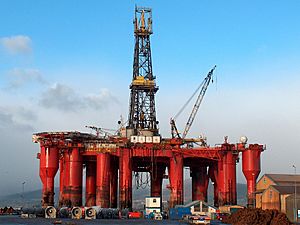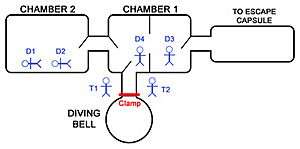Byford Dolphin facts for kids
class="infobox " style="float: right; clear: right; width: 315px; border-spacing: 2px; text-align: left; font-size: 90%;"
| colspan="2" style="text-align: center; font-size: 90%; line-height: 1.5em;" | 
|}
The Byford Dolphin was a special kind of drilling rig that floated on the ocean. It was used to drill for oil and gas deep under the North Sea. This rig was operated by Dolphin Drilling, a company connected to Fred Olsen Energy. It worked in different parts of the North Sea, including areas belonging to Britain, Denmark, and Norway. The Byford Dolphin was eventually taken apart for scrap in 2019.
Sadly, the rig was involved in some serious accidents. The most well-known was a sudden pressure change in 1983. This accident tragically killed four divers and one dive helper, and badly injured another helper.
Contents
| History | |
|---|---|
| Name |
|
| Owner | Byford Dolphin Pte. Ltd. (Fred. Olsen Energy) |
| Operator | Dolphin Drilling |
| Port of registry | |
| Builder | Aker Group |
| Yard number | Aker Verdal A/S (695) |
| Laid down | 31 October 1972 |
| Completed | 1 February 1974 |
| Out of service | Laidup 2016 |
| Identification |
|
| Fate | Beached Aliağa and scrapped 2019 |
| General characteristics | |
| Class and type | DNV class: 1A1 Column-stabilised Drilling Unit UKVS |
| Tonnage | |
| Length | 108.2 m (355 ft) |
| Beam | 67.4 m (221 ft) |
| Depth | 36.6 m (120 ft) |
| Speed | 4.5 kn |
| Capacity |
|
| Crew | 102 berths |
What Was the Byford Dolphin?
The Byford Dolphin was first built in 1974 and named Deep Sea Driller. It was the very first rig of its kind in the successful Aker H-3 series. These rigs were designed by the Aker Group and built at the Aker Verdal shipyard.
The Byford Dolphin was quite large. It was about 108.2 metres (355 ft) long, 67.4 metres (221 ft) wide, and 36.6 metres (120 ft) deep. It could drill down to 6,100 metres (20,000 ft) and work in water as deep as 460 metres (1,500 ft). As a drilling rig, it had advanced equipment for drilling. It also had its own engines to help it stay in place against ocean currents. However, for long trips, special tugboats had to move it.
| Operating deck load | 3,025 tonne |
| Crew quarters | 102 persons |
| Operating water depth | 460 metres (1,500 ft) maximum |
| Derrick | 49 m (160 ft) Shaffer top compensator |
| Mooring system | 12-point |
| Blow-out preventer | Hydril 476 mm (18.7 in), 10,000 kPa (1,500 psi) |
| Sub Sea Handling System | Christmas tree |
| Deck cranes | 2 × 40 tonnes |
Accidents and Problems
Deep Sea Driller Accident (1976)
On March 1, 1976, when the rig was still called Deep Sea Driller, it got stuck on the ground while moving in the North Sea. All the crew members were taken off the rig. However, six people sadly died when they fell out of their rescue boats during the evacuation.
Diving Bell Accident (1983)
On November 5, 1983, a very serious accident happened on the Byford Dolphin. It was drilling in the Frigg gas field in the North Sea. Four divers were inside a special diving chamber system on the rig's deck. This system was connected by a short passage, called a trunk, to a diving bell. The divers were Edwin Arthur Coward, Roy P. Lucas, Bjørn Giæver Bergersen, and Truls Hellevik. Two dive helpers, William Crammond and Martin Saunders, were assisting them.
At the time of the accident, two diving chambers were linked to the diving bell by the trunk. The divers Bergersen and Hellevik had just returned from a dive in the bell and had moved into one of the chambers. Coward and Lucas were resting in another chamber. The whole system was under high pressure, about 9 times normal air pressure.
The usual steps to disconnect the diving bell were:
- Close the diving bell door.
- Close the chamber door.
- Slowly lower the pressure in the trunk to normal air pressure.
- Open a clamp to separate the diving bell from the chambers.
However, one of the helpers, William Crammond, mistakenly opened the clamp that held the trunk sealed. This happened before the chamber door was fully closed. This caused the chamber system to suddenly lose pressure, going from 9 times normal air pressure to normal air pressure almost instantly. Air rushed out with incredible force. This force pushed the diving bell away and hit the two helpers. All four divers died instantly from the extreme pressure change. One of the helpers, Crammond, also died, and Saunders was badly injured.
What the Doctors Found
Doctors examined the divers' bodies. They found that the rapid pressure change caused severe internal injuries. The sudden drop in pressure was so extreme that it caused instant, fatal damage to their bodies. One diver, Truls Hellevik, was caught in the opening as the pressure escaped, leading to severe injuries.
What the Investigation Found
The team that looked into the accident decided it was caused by human error. They believed the dive helper opened the clamp too soon. The design of the trunk door also played a role. It got stuck, leaving a small opening when the pressure escaped. It was unclear if the helper opened the clamp on purpose, by mistake, or due to bad communication. The communication system on the rig was not very good, and the divers often worked very long hours, which could lead to tiredness.
The investigation also pointed to problems with the equipment. The Byford Dolphin's diving system was old and didn't have important safety features. For example, it didn't have special locks that would stop the clamp from being opened while the system was still under pressure. After the accident, new rules were made to make sure all diving systems had these safety features.
Some former crew members and a Norwegian oil union claimed that the investigation didn't tell the whole story. They said that important safety equipment was missing because of special permissions given by the Norwegian Petroleum Directorate. They believed these missing safety features were a big reason for the accident.
Lawsuit and Compensation
The families of the divers who died kept pushing for more investigation. In 2008, a report suggested that faulty equipment was the real cause. Eventually, 26 years after the accident, the families received money from the Norwegian government as compensation for their losses.
Other Incidents
On April 17, 2002, a 44-year-old worker on the rig was killed in an accident when he was hit on the head. Because of this accident, the Byford Dolphin lost a drilling contract with a company called Statoil. This was because Statoil was worried about the rig's safety procedures. This incident cost the company a lot of money.
See also
- Commercial offshore diving
- Saturation diving
- Piper Alpha
- Pioneer, a fictional film set in the 1970s Norwegian oil industry, and which features a fatal decompression chamber accident and its cover-up


